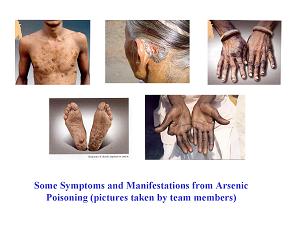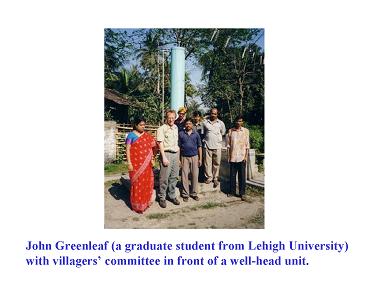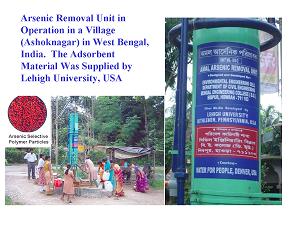Contribute
| Technology - A Novel Reusable Arsenic-Selective Material In Use In Indian Villages |
Arup K. SenGupta
05/06/2005
In Bangladesh and India, drinking water drawn from underground sources
has been responsible for widespread arsenic poisoning affecting over 80
million people. A novel polymer-based hybrid arsenic selective
adsorbent (HAIX), originally developed in Lehigh University,
Pennsylvania, is currently in use in a village (Ashoknagar) in N. 24
Parganas, West Bengal to provide arsenic-free water to three
hundred (300) families who do not have any other source of reliable
drinking water.
The newly synthesized material is
essentially an ion exchanging polymer within which the nanoscale iron
oxide particles have been dispersed using a chemical-thermal technique
developed at Lehigh University. The effort was part of an ongoing
collaborative project between Lehigh University in PA, USA and Bengal
Engineering College in Howrah, West Bengal. The project is partially
funded by the Water For People (WFP) in Denver, Colorado. The
concentration of arsenic in the groundwater in the village is over 100
parts per billion. Arsenic concentration in the treated water is
consistently less than 10 parts per billion in the well-head treatment
unit although the current Indian standard requires 50 parts per
billion. The arsenic-selective material, ArsenX, is very durable,
mechanically strong and now commercially available through a licensee
agreement between Lehigh University and SolmeteX Co., MA
(www.solmetex.com). The material is amenable to efficient regeneration
and can be reused for tens of cycles.
Several metal oxide nanoparticles offer high sorption affinity toward
toxic arsenic compounds present in contaminated groundwater in Indian
subcontinent. However, these metal oxide particles are mechanically
weak and not durable. On the contrary, polymeric ion exchangers are
mechanically strong and very robust but have poor sorption affinity for
arsenic compounds. At Lehigh University, hybrid particles have been
prepared by dispersing iron oxide nanoparticles within polymer beads
containing appropriate ion exchange properties. These hybrid particles
(HAIX) are spherical, extremely durable and highly arsenic selective.
They are also amenable to regeneration and reuse for tens of cycles
with life expectancy of over ten years. Besides being in use in two
villages in West Bengal, the HAIX material is undergoing field trials
in California, New Mexico, Arizona and New Hampshire for application in
North America.
The hybrid adsorbent material (HAIX) is capable
of removing both arsenic(V) and arsenic(III) simultaneously. The
well-head arsenic removal system is operationally simple and does not
require any electricity or addition of chemicals. Villagers are
responsible for day to day operation of the unit through a villagers’
committee and each family contributes 30 US cents (10 Indian Rupees.)
for the upkeep and regeneration of the unit. More pertinent information
is available in http://www.lehigh.edu/~aks0/aks0.html
You may also access this article through our web-site http://www.lokvani.com/




